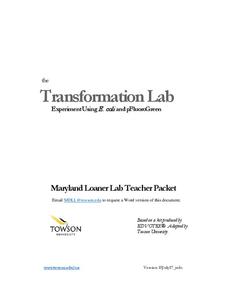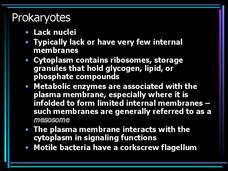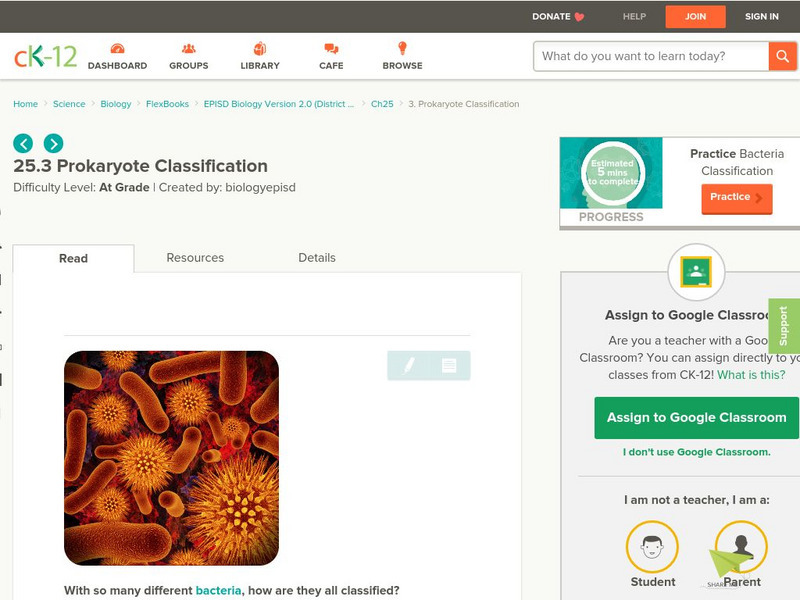Virginia Department of Education
Prokaryotes
Lead your biology class on a cell-sized adventure! Emerging scientists construct models of prokaryotes, then design an experiment to properly grow a bacterial culture. They conclude the activity by viewing the culture under a microscope....
Learning Games Lab
Gram Staining
Scholars use a lab simulation to test contaminated yogurt for bacteria by gram staining. They learn proper lab procedures for handling bacteria and for sterilizing equipment, and then walk through the process on their own to try gram...
Towson University
Transformation Lab
Transform your class' understanding of genes and antibiotic resistance with the Transformation Lab. Junior geneticists create and observe their own resistant strains of E. coli through research, discussion, and experimentation. The...
Prezi
The Six Kingdoms
Why can't dinosaurs clap their hands? Because they no longer exist. The six kingdoms do exist, and through the presentation individuals discover kingdom names, their description, and view photographs of a few samples.
Teacher Web
Archaebacteria and Eubacteria
Take young biologists back to the beginning of life on Earth with this presentation on bacteria. Examining the different classifications of bacteria, this presentation introduces young scientists to the concepts of autotrophs and...
Curated OER
Bacteria
The first slide lists the six kingdoms in the biological hierarchy, but the remaining 10 slides cover characteristics of archaebacteria and eubacteria. Topics include how energy is obtained, arrangement, and shape. This brief, but...
Curated OER
Bacteria - Our Invisible Friends
A concise, yet comprehensive note-taking guide is provided by this collection of slides. Using the bullet-point format, the different types, shapes, and characteristics of bacteria are listed. This resource would be of great value as an...
Curated OER
Bacteria
New species of Bacteria are still being discovered. These Archaebacteria and Eubacteria are described, and examples of the main sub-groups are included along with some diagrams about reproduction, nutrition, and effects.
Curated OER
Viruses and Bacteria
A series of questions about archaebacteria and eubacteria reinforce a chapter on viruses and bacteria. This worksheet is from chapter 18 of an unspecified textbook, but could work with your biology lecture as well. High schoolers...
Curated OER
Prokaryotes
Although these slides are text rich, the summaries of prokaryote characteristics will be useful. There are diagrams of preferred cell conditions and your students will find all the basic definitions of structure and functions useful. ...
Curated OER
Prokaryote Coloring
In this prokaryote worksheet, students answer ten questions about prokaryote cells and they color a diagram of a simple bacteria cell and its structures.
Curated OER
Six Kingdom System of Classification
In this classification worksheet, students complete a graphic organizer comparing and contrasting the characteristics of the 6 different kingdoms.
Curated OER
The Six Kingdoms
In this kingdoms worksheet, learners compare the six different kingdoms. Students complete 2 short answer questions based on this information.
Curated OER
Modern Classification
In this modern classification worksheet, 9th graders describe ways scientists determine an organism's phylogeny. Then they explain what the animal and fungi kingdoms have in common and how they differ. Students also classify some cells...
City University of New York
Brooklyn College: Direct Microscopic Counts
Guidelines for an activity through which you, acting as a research assistant for a wine merchant, work to grow a microbe under different conditions.
University of California
Ucmp: Cyanobacteria
General information on the cyanobacteria, the blue-green algae and the features that make them different from prokaryotic bacteria. Also included are pages that point to more specific info, like life history and fossil records.
Tree of Life Project
The Tree of Life Web Project
The Tree of Life is a multi-authored, Internet distributed project containing information about phylogeny and biodiversity. The Tree of Life can be used to locate information about a particular group of organisms through their taxonomy.
CK-12 Foundation
Ck 12: Episd: Prokaryote Classification
[Free Registration/Login may be required to access all resource tools.] Students will understand where bacteria live, the different types of prokaryotes, and extremephilic bacteria.
City University of New York
Brooklyn College: The World of Cells: Prokaryotic Cells
A very nice introduction to this group organized in a concise, easy to follow format.
University of California
Ucmp: Introduction to Bacteria
This site provides an introduction to bacteria and examines fossil records, life history and ecology, systematics, and morphology.
Estrella Mountain Community College
Online Biology Book: Biological Diversity: Bacteria and Archaeans
In this online biology textbook, learn about the two prokaryotic domains of life, which include eubacteria and acrhaebacteria.
US National Library of Medicine
Medline Plus: Necrotizing Tissue Infection
Fact sheet describing a rare type of bacterial infection. Includes causes, symptoms, treatment, and prevention.
CK-12 Foundation
Ck 12: Biology: Prokaryote Classification
[Free Registration/Login may be required to access all resource tools.] Overview of classifying prokaryotes and prokaryotic domains.
CK-12 Foundation
Ck 12: Life Science: Bacteria Nutrition
[Free Registration/Login may be required to access all resource tools.] Like all organisms, bacteria need energy, and they can acquire this energy through a number of different ways. Learn more about bacteria nutrition in this learning...

























